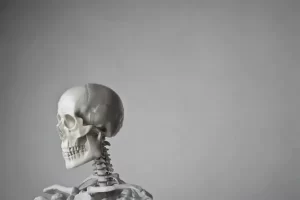The term ‘osteoporosis’ means ‘porous bone.’ Osteoporosis is a medical condition in which bones become weak and brittle. It typically develops when bone mass and mineral density decreases, which increases your risk of fractures.
Osteoporosis affects both women and men, typically after age 50. People suffering from this disease often don’t notice anything until their bones fracture. These fractures will be felt in the spine, wrist, and hip.
You may be suffering from osteoporosis if you have spine malformations, loss of height, and severe back pain. Developing a stooped posture and breaking bones in a relatively minor fall or accident may also be indications of osteoporosis.
Here is what you need to know about this medical condition.
Causes of Osteoporosis
Multiple factors can increase your chances of contracting osteoporosis.
- Age — As you age, your bone mass is lost faster than it’s created.
- Body frame size — People with a small body frame have an increased likelihood of contracting osteoporosis due to their less bone mass.
- Family history — If one of your parents has a bone fracture, you may need to be screened for osteoporosis.
- Your sex — Osteoporosis cases are higher in women than in men.
- Race — White and Asian people have higher incidences of osteoporosis than non-Hispanic black people.
- Thyroid problems — Excess thyroid hormones can speed the rate at which your bone mass is lost.
- Sex hormones — Low levels of testosterone in men and estrogen in women can lead to bone loss.
- Low calcium intake — Inadequate calcium intake can increase the risk of osteoporosis by making the bones brittle.
How to Treat or Manage Osteoporosis
You can slow down bone loss and reduce the risk of breaking your bones if you make certain lifestyle changes. Some of the things you can do include:
Exercise regularly
It may sound strange that a person with fragile bones should engage in physical exercise. However, a well-designed exercise routine can actually help to prevent fractures and falls. This is because physical activity strengthens muscles and bones while boosting flexibility, coordination, and balance.
Some of the main bone-strengthening exercises include:
- Weight-bearing exercises — They are workouts you do on the feet to make your muscles and bones work against gravity and keep you upright. For instance, yoga, dancing, gardening, stair-climbing, elliptical training, and low-impact aerobics work directly on the bones in your lower spine, hips, and legs. You can either do these exercises at home or join a gym. Either way, it is recommended that you should do these exercises for half an hour on most days of the week.
- Muscle-strengthening exercises — Some muscle-strengthening activities such as lifting weights and working with resistance bands can help manage or prevent osteoporosis. These exercises improve your bone strength and mineral density.
- Walking — Regular walking builds and maintains strong bones while boosting muscle strength. The result is a reduction in osteoporosis-related fractures.
- Squats — Moderate squat is a recommended exercise for osteoporosis since it can improve skeletal properties in postmenopausal women.
Watch your diet
Not only can your diet increase the risk of osteoporosis, but it can also make it difficult to manage the condition. Therefore, you should restructure your diet and start consuming plenty of calcium. It is recommended that adults between the ages of 19 and 50 as well as men aged 51 to 70 consume 1,000 mg of calcium each day. Women aged 51 to 70 are advised to eat 1,200 mg of calcium per day.
Calcium is an important mineral in combating osteoporosis because it is involved in the formation of bones. When you consume high amounts of calcium, you increase your bone density. The body is also able to easily remodel new bones when the calcium intake is high.
Dairy products such as yogurt, cheese, and milk have high amounts of calcium. Dark green leafy vegetables and calcium-fortified foods also provide a healthy dose of calcium. Other sources include dried figs, tofu, white beans, and sunflower seeds.
Get enough vitamin D
Consuming large amounts of calcium is not helpful if it is not absorbed into the bloodstream. Consequently, you should get substantial amounts of vitamin D to aid in the absorption of calcium from ingested food.
Sunlight is the primary source of vitamin D. As a result, you should aim to get 10-30 minutes of midday sunlight every day. Other sources of vitamin D include salmon, herring and sardines, canned tuna, and egg yolks.
Avoid smoking
Smoking has adverse effects on bone strength and health. In particular, chain smokers have an increased risk of bone fractures. Similarly, it has been noted that it will take twice as long for smokers to heal their broken bones than people who don’t smoke.
Therefore, quitting smoking is one of the major lifestyle changes associated with osteoporosis treatment and management. You can try nicotine replacement therapy or practice relaxation techniques. Medicines that curb nicotine cravings and regular exercises can also help you to quit smoking.
Avoid alcohol
Chronic alcohol consumption can dramatically compromise your bone quality and increase the risk of contracting osteoporosis. Alcohol affects bone density and how first your body absorbs bone-forming nutrients. It can also reduce the speed at which bone cells rebuild themselves.
As such, you should reduce or completely avoid alcohol consumption. Start by choosing alcohol-free days and keeping yourself busy by taking a walk or catching a movie. Similarly, consider joining addiction support groups.
Manage Your Osteoporosis Condition
Osteoporosis is a medical condition that can be managed by simple lifestyle changes. Regular exercise, a change of diet, and avoiding smoking and alcohol consumption can strengthen your bones and reduce fractures.
Matthews Internal Medicine helps osteoporosis patients to cope and recover from the disease. Contact us for more information.


